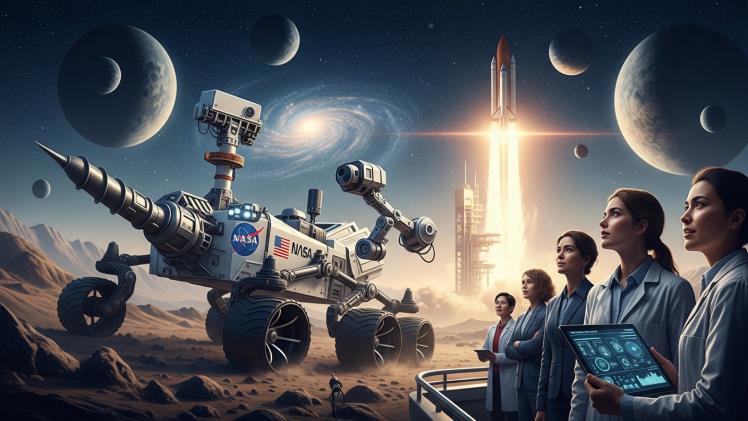NASA driving space exploration that expands knowledge and inspires technological progress
NASA has been at the forefront of space exploration for decades, pioneering missions that extend humanity’s understanding of the universe. From the historic Apollo moon landings to the exploration of Mars and beyond, NASA efforts have consistently expanded the boundaries of scientific knowledge. Space exploration is not merely a quest for discovery; it is a driver of innovation, technology, and global inspiration. By studying planets, stars, and cosmic phenomena, NASA contributes to a broader understanding of the universe and humanity’s place within it.
The agency’s missions are meticulously planned and executed, often combining the expertise of engineers, scientists, and researchers across multiple disciplines. These missions range from robotic probes that gather data from distant celestial bodies to human spaceflight programs that test the limits of human endurance and capability. Each mission provides valuable insights that can inform future explorations and inspire generations of scientists, engineers, and explorers.
What Role Do Robotic Missions Play in Expanding Knowledge?
Robotic missions are central to NASA’s exploration strategy. They allow scientists to gather data from environments that are currently unreachable or too hazardous for human astronauts. Rovers, orbiters, and landers are equipped with advanced instruments capable of analyzing soil, atmosphere, magnetic fields, and other crucial parameters.
For example, robotic missions to Mars have revealed evidence of past water activity, climate variations, and geological processes. These discoveries enhance our understanding of planetary evolution and potential habitability. Similarly, missions to asteroids and comets provide insights into the origins of the solar system, including the building blocks of life. The data collected by these robotic explorers form the foundation for more ambitious human missions, offering critical information that ensures safety and mission success.
How Does Human Spaceflight Advance Technology and Knowledge?
Human spaceflight is one of NASA’s most ambitious endeavors. Sending astronauts beyond Earth’s atmosphere not only pushes the limits of human endurance but also drives advancements in life support systems, materials science, and medical research. Long-duration missions aboard the International Space Station, for example, allow scientists to study the effects of microgravity on the human body, which has implications for both space exploration and healthcare on Earth.
Human spaceflight programs also test cutting-edge propulsion technologies and spacecraft systems. Each mission serves as an experimental platform for new materials, energy-efficient designs, and communication technologies. These innovations have applications beyond space exploration, influencing industries such as transportation, robotics, and electronics. In essence, human spaceflight exemplifies the synergy between exploration, scientific discovery, and technological progress.
Why Is NASA a Driver of Technological Innovation?
NASA’s exploration missions require the development of advanced technologies that often exceed the current limits of engineering. The agency invests in propulsion systems, robotics, artificial intelligence, and data analysis tools, pushing technology to new heights. Innovations originally developed for space applications frequently find their way into everyday life, enhancing industries and improving quality of life on Earth.
For instance, technologies for satellite imaging, weather prediction, and telecommunications owe much to advancements driven by space exploration. Materials designed to withstand extreme conditions in space have led to improvements in healthcare devices, construction materials, and transportation systems. NASA’s commitment to research and development ensures that space exploration not only expands scientific understanding but also drives practical technological progress.
How Does NASA Inspire Scientific Curiosity and Education?
NASA’s missions inspire millions of people worldwide to engage with science, technology, engineering, and mathematics (STEM). Public outreach programs, educational resources, and interactive platforms allow students and enthusiasts to explore space-related topics. By fostering curiosity and providing opportunities to participate in simulations, experiments, and citizen science projects, NASA encourages the next generation of explorers and innovators.
The agency’s achievements serve as powerful examples of what can be accomplished through collaboration, dedication, and scientific inquiry. From live mission broadcasts to virtual tours of spacecraft and laboratories, NASA makes space exploration accessible and exciting. This inspiration often motivates students to pursue careers in STEM fields, contributing to the broader scientific and technological workforce.
What Are NASA’s Contributions to Earth Science and Global Understanding?
NASA’s work extends beyond the exploration of other planets. The agency conducts extensive Earth observation programs, using satellites and remote sensing technology to monitor climate patterns, natural disasters, and environmental changes. These studies provide valuable insights into global weather systems, ocean currents, deforestation, and atmospheric conditions.
By tracking changes in Earth’s environment, NASA helps policymakers, scientists, and communities make informed decisions about resource management, disaster preparedness, and climate action. The data collected also contributes to long-term research on climate change, supporting initiatives that promote sustainability and resilience. In this way, NASA bridges space exploration with practical applications that benefit life on Earth.
How Do Collaborative Efforts Enhance NASA’s Missions?
International collaboration is a hallmark of NASA’s approach to space exploration. Partnering with other space agencies, universities, and research institutions enables shared expertise, resources, and technological capabilities. Collaborative projects such as the International Space Station demonstrate the value of global cooperation in tackling complex challenges.
Joint missions with international partners expand the scope of exploration while distributing costs and risks. They also foster diplomatic and scientific relationships that strengthen global networks of knowledge and innovation. By working collaboratively, NASA ensures that its missions have a broader impact, advancing science and technology on a worldwide scale.
Why Is the Search for Life Beyond Earth Important?
One of NASA’s most compelling missions is the search for life beyond Earth. Understanding whether life exists elsewhere in the universe addresses fundamental questions about existence, evolution, and the uniqueness of our planet. Missions targeting Mars, icy moons like Europa, and distant exoplanets aim to detect signs of past or present life and study conditions that might support biological activity.
Discovering extraterrestrial life, even in microbial form, would revolutionize our understanding of biology, chemistry, and planetary science. It would also inspire philosophical and ethical discussions about humanity’s place in the cosmos. This pursuit underscores NASA’s commitment to pushing the boundaries of knowledge and exploring questions that have fascinated humans for centuries.
How Does NASA Promote Innovation in Space Technology?
NASA’s focus on technological innovation drives the development of new propulsion systems, energy storage solutions, and autonomous exploration technologies. These innovations reduce mission costs, enhance efficiency, and enable more ambitious objectives, such as deep-space exploration and planetary colonization.
For example, advanced robotic systems equipped with artificial intelligence can operate autonomously in remote environments, reducing risk to human astronauts. Similarly, solar energy and nuclear power solutions are being developed to support long-duration missions. By investing in these technologies, NASA ensures that future space exploration is sustainable, safe, and capable of reaching further into the cosmos.
What Is the Role of Satellites in NASA’s Exploration Goals?
Satellites play a crucial role in both space exploration and Earth observation. NASA deploys satellites to study planetary atmospheres, monitor space weather, and collect high-resolution images of celestial bodies. These instruments provide detailed data that guide mission planning, inform scientific research, and enhance understanding of the universe.
In addition to their scientific contributions, satellites have practical applications on Earth. Communication, navigation, environmental monitoring, and disaster response rely heavily on satellite technology. NASA’s expertise in satellite design, launch, and operation ensures that these systems are reliable and capable of meeting diverse scientific and societal needs.
How Does NASA Inspire Global Engagement and Curiosity?
NASA’s achievements resonate worldwide, inspiring individuals, communities, and institutions to explore, learn, and innovate. Public engagement initiatives, such as live-streamed launches, educational apps, and citizen science projects, allow people to participate in the excitement of space exploration.
The agency’s work also influences culture, art, and media. Movies, documentaries, and books about space exploration draw inspiration from NASA’s missions, making science accessible and captivating to broader audiences. This global engagement encourages cross-disciplinary collaboration, creativity, and a shared sense of curiosity about the universe.
What Are the Challenges and Opportunities Ahead for NASA?
NASA faces challenges such as budget constraints, technical complexities, and the inherent risks of space travel. Long-duration missions to the Moon, Mars, and beyond require careful planning, resource management, and innovative solutions to sustain human life and ensure mission success.
At the same time, these challenges present opportunities for growth, innovation, and leadership. Advances in propulsion, life support, artificial intelligence, and materials science have the potential to transform space exploration. By overcoming obstacles, NASA continues to expand human knowledge, inspire technological progress, and pave the way for future generations of explorers.
Conclusion
NASA’s role in space exploration goes beyond launching rockets or sending probes. It is a driving force for expanding human knowledge, inspiring innovation, and fostering global curiosity. Through robotic missions, human spaceflight, technological advancement, and educational outreach, NASA has redefined what is possible in science and exploration.







